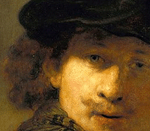
"The Baptism of Christ"
The name Johannes Barontius appears in the signature of an altarpiece dated 1345. Representing the Madonna and Child Enthroned with Saints (Galleria Nazionale, Urbino), it comes from the church of San Francesco at Macerata Feltria. Usually, Barontius (the latinized form of Baronzio) is considered a surname, but a document of 1362 recording the painter’s tomb in the church of San Giuliano at Rimini (where he was buried, together with his brother and a son) makes it clear that it was a patronymic. The only other piece of documentary evidence found thus far is a deed dated 1343 that cites “Iohanne Baroncio pictore” as a witness.
The painter, who may be said to have been a disciple of Giotto (Florentine, c. 1265 - 1337) but at second hand, must have begun his career around 1320 or a little later under the more immediate influence of Giovanni and Pietro da Rimini. His probable first works include the stories of Christ now divided between the Galleria Nazionale d’Arte Antica di Palazzo Barberini in Rome and the Fondazione Cassa di Risparmio in Rimini formerly assigned to the Pseudo-Baronzio. Fragments of an altarpiece depicting the Madonna and Child and stories of the life of the Baptist, including the panels now in the National Gallery of Art, and panels formerly gathered under the name Master of the Parry Adoration belong to a subsequent phase in Baronzio’s development.